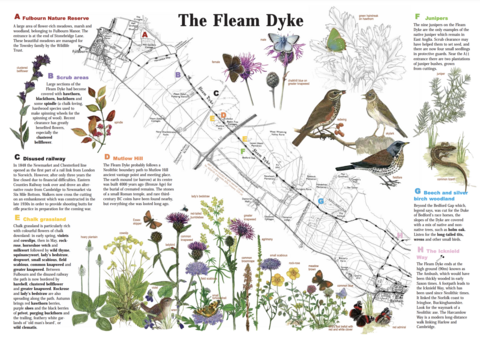Fleam Dyke, the huge earthwork monument running between Fulbourn and Balsham in Cambridgeshire is an impressive presence in the landscape. We took the opportunity to bring a significant length of the Dyke into our ownership, extending the habitat, and creating a larger, better connected nature reserve, linking to and incorporating Fulbourn Fen. Thanks to a highly successful appeal our plans are now coming to fruition.
The section between Fulbourn Fen and Mutlow Hill, together with a further 7.6 hectares of arable land adjacent to the Dyke, will now see the creation of new chalk grassland habitat for the benefit of all chalk flora and fauna, enabling a more sustainable management of Fleam Dyke.
Our management will focus initially on the remnant chalk area on Mutlow Hill, then along the footpath and upper slopes of Fleam Dyke, with restoration of areas of scrub on the middle and lower slopes taking place in the future. The additional arable land will be sown with a chalk grassland wildflower mix in 2024, and, in the fullness of time, Fulbourn Fen and Fleam Dyke will become a single site, managed through conservation grazing with a mixture of cattle and sheep.
Grassland improvements will allow the rich range of wildflowers to flourish - early spring sees violets and cowslips, followed by low growing plants typical of chalk grassland - common rock rose, horseshoe vetch, wild thyme, milkwort and eyebright. By summer lady’s bedstraw forms a backdrop to the mauve, purple and blue of knapweeds, small scabious, field scabious, clustered bellflowers and harebells together with salad burnet, dropwort, restharrow and ploughman’s-spikenard. Patches of starry white squinancywort, bright pink sainfoin and an occasional pyramidal orchid may also be seen.
Constructed sometime between the 4th and 5th centuries by Anglo Saxon settlers, Fleam Dyke is three miles long and seven metres high from ditch to bank, forming a barrier across the open chalkland ridge. Most probably designed for defensive purposes, it later served as a boundary between the Flendish and Staine Hundreds (most counties in England were divided into hundreds - larger than villages but smaller than shires). The Flendish Hundred was mentioned in the Doomsday Book and included Fulbourn, Fen Ditton and Horningsea, while the Staine Hundred included Great and Little Wilbraham, Stow, Quy and Bottisham. Hundreds were later abandoned as administrative divisions in the 19th century.
Mutlow Hill is a Bronze Age burial barrow dated to 2000BC which was excavated in the 1850s and found to contain eight funeral urns holding cremated remains and some beads originating from the Mediterranean. Between 1912 and 1915, Fleam Dyke was one of 286 sites selected by Charles Rothschild, founder of the Wildlife Trusts movement, as a wildlife site worthy of preservation - the entire site is now a Scheduled Monument and a Site of Special Scientific Interest.





